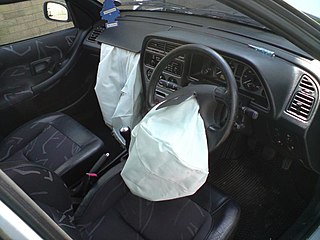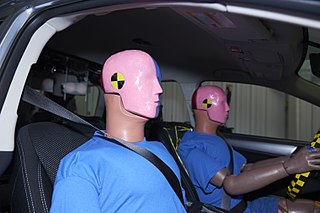
An airbag is a vehicle occupant-restraint system using a bag designed to inflate extremely quickly, then quickly deflate during a collision. It consists of an airbag cushion, a flexible fabric bag, an inflation module, and an impact sensor. The purpose of the airbag is to provide a vehicle occupant with soft cushioning and restraint during a collision. It can reduce injuries between the flailing occupant and the interior of the vehicle.

A crash test dummy, or simply dummy, is a full-scale anthropomorphic test device (ATD) that simulates the dimensions, weight proportions and articulation of the human body during a traffic collision. Dummies are used by researchers, automobile and aircraft manufacturers to predict the injuries a person might sustain in a crash. Modern dummies are usually instrumented to record data such as velocity of impact, crushing force, bending, folding, or torque of the body, and deceleration rates during a collision.

Crumple zones, crush zones, or crash zones are a structural safety feature used in vehicles, mainly in automobiles, to increase the time over which a change in velocity occurs from the impact during a collision by a controlled deformation; in recent years, it is also incorporated into trains and railcars.

A crash test is a form of destructive testing usually performed in order to ensure safe design standards in crashworthiness and crash compatibility for various modes of transportation or related systems and components.

Automotive safety is the study and practice of automotive design, construction, equipment and regulation to minimize the occurrence and consequences of traffic collisions involving motor vehicles. Road traffic safety more broadly includes roadway design.

A bumper is a structure attached to or integrated with the front and rear ends of a motor vehicle, to absorb impact in a minor collision, ideally minimizing repair costs. Stiff metal bumpers appeared on automobiles as early as 1904 that had a mainly ornamental function. Numerous developments, improvements in materials and technologies, as well as greater focus on functionality for protecting vehicle components and improving safety have changed bumpers over the years. Bumpers ideally minimize height mismatches between vehicles and protect pedestrians from injury. Regulatory measures have been enacted to reduce vehicle repair costs and, more recently, impact on pedestrians.

The European New Car Assessment Programme is a European voluntary car safety performance assessment programme based in Leuven, Belgium. Formed in 1996, the first results were released in February 1997. It was originally started by the Transport Research Laboratory for the UK Department for Transport but later backed by several European governments, as well as by the European Union (EU). Their slogan is "For Safer Cars".
The National Highway Traffic Safety Administration is an agency of the U.S. federal government, part of the Department of Transportation, focused on transportation safety in the United States.

The Chevrolet Venture is a minivan produced by General Motors for the 1997 to 2005 model years. The Chevrolet Venture, along with most of its General Motors minivan siblings, was built at GM's Doraville, Georgia, assembly plant.

The Insurance Institute for Highway Safety and Highway Loss Data Institute (IIHS-HLDI) is an American nonprofit organization. It was established in 1959, and it is noted for its safety reviews of vehicles in various simulated traffic situations, including the effectiveness of a vehicle's structural integrity and safety systems during a collision, in addition to examining improvement on such elements.

The Fiat 500 is an A-segment city car manufactured and marketed by the Fiat subdivision of Stellantis since 2007. It is available in hatchback coupé and fixed-profile convertible body styles, over a single generation — with an intermediate facelift in Europe with model year 2016. The 500 is internally designated as the Type 312 by FCA.

Whiplash Protection System (WHIPS) is a system to protect against automotive whiplash injuries introduced by Volvo in 1998. It was launched when the Volvo S80 was released for the 1999 model year and has since been part of the standard equipment of all new Volvo cars.

A collision avoidance system (CAS), also known as a pre-crash system, forward collision warning system (FCW), or collision mitigation system, is an advanced driver-assistance system designed to prevent or reduce the severity of a collision. In its basic form, a forward collision warning system monitors a vehicle's speed, the speed of the vehicle in front of it, and the distance between the vehicles, so that it can provide a warning to the driver if the vehicles get too close, potentially helping to avoid a crash. Various technologies and sensors that are used include radar (all-weather) and sometimes laser (LIDAR) and cameras to detect an imminent crash. GPS sensors can detect fixed dangers such as approaching stop signs through a location database. Pedestrian detection can also be a feature of these types of systems.
G-Con is Honda Motor Co.'s internal passive safety standard. G-Con is short for G-Force Control. The standards incorporated into G-Con are constantly updated to benchmark against many of the world's toughest crash safety regulations as well as against data collected from real-world accident cases. The objective of G-Con is to control the impact energy (G-force) of a collision and reduce injuries to the vehicle occupants.

The Latin New Car Assessment Programme is an automobile safety assessment programme for Latin America and the Caribbean. Founded in 2010, it offers independent information to consumers about the safety levels of new cars in the market. Latin NCAP tests are based in international renowned methodologies, with vehicles awarded a safety rating between 0 and 5 stars, indicating the protection the cars offer to adult and child occupants. The programme started as a joint initiative and in 2014 it was established as an association under a legal entity framework.

The World Forum for Harmonization of Vehicle Regulations define AEBS. UN ECE regulation 131 requires a system which can automatically detect a potential forward collision and activate the vehicle braking system to decelerate a vehicle with the purpose of avoiding or mitigating a collision. UN ECE regulation 152 says deceleration has to be at least 5 metres per second squared.

A New Car Assessment Program is a government car safety program tasked with evaluating new automobile designs for performance against various safety threats.
The Bharat New Car Assessment Program, usually known as the Bharat NCAP, is a upcoming New Car Assessment Program for India. Cars sold in the country will be assigned by star ratings based on their safety performance. It will be implemented in phases, according to the plans being drawn up by the National Automotive Testing and R&D Infrastructure Project. It is the 10th NCAP in the world and is being set up by the government of India.
specialises in vehicle crashworthiness with a background in accident and injury investigation/analysis.
The GlobalNew Car Assessment Programme is a project of the Towards Zero Foundation, a UK-registered charity. The programme aims to promote the sale of safer cars in developing markets by empowering consumers with objective information about the safety of vehicles. Global NCAP supports the UN Sustainable Development Goals and the target to halve road deaths and injuries by 2030, and the full implementation of the Global Plan for the UN's Decade of Action for Road Safety especially the recommended activities for vehicles.



















